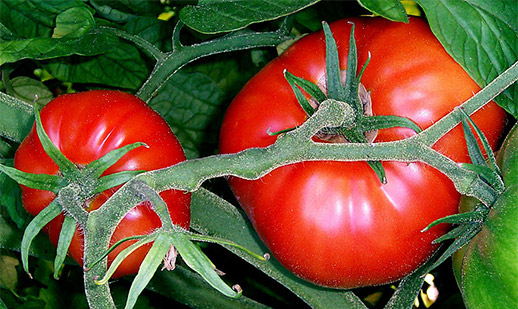Mycorrhiza and Tomatoes
Increased growth, higher fruit quality.

Benefits of Mycorrhiza for Tomato growers

|
|
Our product for Tomatoes – Mycorrhiza Soluble
Use a 30g pack for up to 25 m² of soil surface. Mix the Mycorrhiza well with water and water it to the plants.
The most natural way to fertilize your tomatoes.
Buy now >>
Mycorrhiza and Tomatoes
Research shows the benefit of mycorrrhiza application in tomato production. Mycorrhiza raise harvest by increasing plant grow (+30%) and percentage of large fruits (+76%) and extra-large fruits (+44 %) as well as earlier yield1.
Especially when tomatoes are produced for industrial processing a high fruit quality, tastefulness and rich flavour is appreciated. Taste and flavour is particularly increased by higher sugar content in the fruits3. Research shows that tomatoes in symbioses with mycorrrhiza have a higher content of vitamin C (+23%)1 and Lycopene2, also the content of sugars (fructose and glucose)2 is increased.
Mycorrhiza plant fertilizer increase harvest yield
Since about 40 years now the team play between Mycorrhiza-fungi and plants is of particular interest to science. Today you can benefit from this symbiosis and naturally stimulate growth and efflorescence of your plants.
The name Mycorrhiza is composed of the Greek words mýkēs ('fungus') and rhíza ('root'). Out in nature 'mycorrhizal' species and plant roots form a symbiotic relationship for mutual benefit. Fossil records have shown that this partnership developed about 500 million years ago, along with the colonisation of the dry land by the first plants.
Mycorrhiza boosts root growth, improves nutrient uptake, leaf growth and flowering and raises crop yields of 95% of all crop and decorative plants while reducing repotting stress, water- and fertiliser consumption as well as drought stress.
We offer Mycorrhiza products for hobbyists and for professional users in four variations; as granular, powder to solubilize, seed inoculant and as tablets.
Application is easy, the cost are only few cents per plant!
The most natural way to fertilize your plants.
Buy now >>
Quellen:
1) Nzanza, Bombiti, Diana Marais, and Puffy Soundy. "Response of tomato (Solanum lycopersicum L.) to nursery inoculation with Trichoderma harzianum and arbuscular mycorrhizal fungi under field conditions." Acta Agriculturae Scandinavica, Section B-Soil & Plant Science 62, no. 3 (2012): 209-215.
2) Copetta, A., L. Bardi, E. Bertolone, and G. Berta. "Fruit production and quality of tomato plants (Solanum lycopersicum L.) are affected by green compost and arbuscular mycorrhizal fungi." Plant Biosystems 145, no. 1 (2011): 106-115.
3) Malundo, T. M. M., R. L. Shewfelt, and J. W. Scott. "Flavor quality of fresh tomato (Lycopersicon esculentum Mill.) as affected by sugar and acid levels." Postharvest Biology and Technology 6, no. 1 (1995): 103-110.
4) Aguilera-Gomez, L., FT Jr Davies, V. Olalde-Portugal, S. A. Duray, and L. Phavaphutanon. "Influence of phosphorus and endomycorrhiza (Glomus intraradices) on gas exchange and plant growth of chile ancho pepper (Capsicum annuum L. cv. San Luis)." Photosynthetica 36, no. 3 (1999): 441-449.
5) Mena-Violante, Hortencia G., Omar Ocampo-Jiménez, Luc Dendooven, Gerardo Martínez-Soto, Jaquelina González-Castañeda, Fred T. Davies Jr, and Víctor Olalde-Portugal. "Arbuscular mycorrhizal fungi enhance fruit growth and quality of chile ancho (Capsicum annuum L. cv San Luis) plants exposed to drought." Mycorrhiza 16, no. 4 (2006): 261-267.
6) Sahi, Irfan Yousaf, and A. N. Khalid. "In vit o biological control of Fusarium oxysporum-r causing wilt in Capsicum annuum." (2007).
7) Ahmed, A. Sid, M. Ezziyyani, C. Pérez Sánchez, and Mª E. Candela. "Effect of chitin on biological control activity of Bacillus spp. and Trichoderma harzianum against root rot disease in pepper (Capsicum annuum) plants." European Journal of Plant Pathology 109, no. 6 (2003): 633-637.
8) Ahmed, Ahmed Sid, Consuelo Pérez Sánchez, and Maria Emilia Candela. "Evaluation of induction of systemic resistance in pepper plants (Capsicum annuum) to Phytophthora capsici using Trichoderma harzianum and its relation with capsidiol accumulation." European Journal of Plant Pathology 106, no. 9 (2000): 817-824.

